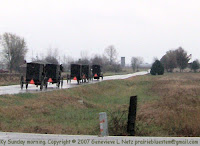The Rural Life... History and Old Stuff...
I don't often think about the tremendous changes the automobile brought about (besides air pollution, roadkill and oil cartels), but today I was reminded by an essay question in a 1941 textbook.
Think of a farmer 30 years ago without an automobile. Then think of him to-day as the owner of an automobile for himself and family, and a motor truck for taking his products to market and bringing home supplies, and describe the change in his life made by his possessing these vehicles.
Source: Our World Today (p. 619), a geography textbook written by De Forest Stull and Roy W. Hatch and copyrighted in 1941 by Allyn and Bacon, Boston, MA
My parents were both born in 1923, while America was making the transition from horse-drawn conveyances and machinery to gasoline powered vehicles and machinery.
My father remembered going to the nearest little town in a horse-drawn wagon to hear preaching at a tent meeting when he was a little boy. He also mentioned that the first automobiles that they owned didn't have automatic windshield wipers. They were a welcome innovation!
My mother could remember the livery stable that her grandfather, Marcus Eaton, ran in Gordon, Nebraska. I am not sure when it finally closed, but probably the advent of the automobile was as much a factor as my grandfather's age.
Here are some interesting facts about the growth of the automobile industry, taken from Our World Today (cited above).
1895 -- 300 automobiles produced
1899 -- 4000 automobiles produced
1930 -- 6,000,000 automobiles produced, and 88% were manufactured in the U.S. and Canada
1940 -- 45,000,000 cars owned worldwide, and over 2/3 of them in America
 Many people of the Amish and Mennonite faith in this part of Kentucky still use horses and buggies. Our more conservative Amish neighbors don't drive gasoline-powered machines of any sort, but they do use stationary gasoline motors to run some farm equipment. Most of our Mennonite neighbors use modern gasoline-powered machinery, but don't drive cars.
Many people of the Amish and Mennonite faith in this part of Kentucky still use horses and buggies. Our more conservative Amish neighbors don't drive gasoline-powered machines of any sort, but they do use stationary gasoline motors to run some farm equipment. Most of our Mennonite neighbors use modern gasoline-powered machinery, but don't drive cars.Even though these people reject the ownership of automobiles, trucks take deliveries to and from their farms. They routinely hire an automobile and driver if they are going to town, and virtually every product they buy there has been brought to the store by a truck. Their mail is delivered by a rural carrier in a car.
They don't live like a farmer in a developing country who raises a crop, takes the products to market and brings home supplies using only animal-power -- or even his own back.
They aren't even much like the American farmer of 1911, mentioned in the essay question above. Even if they wanted to live that way, I don't think they could in America.
Technorati tag:
No comments:
Post a Comment